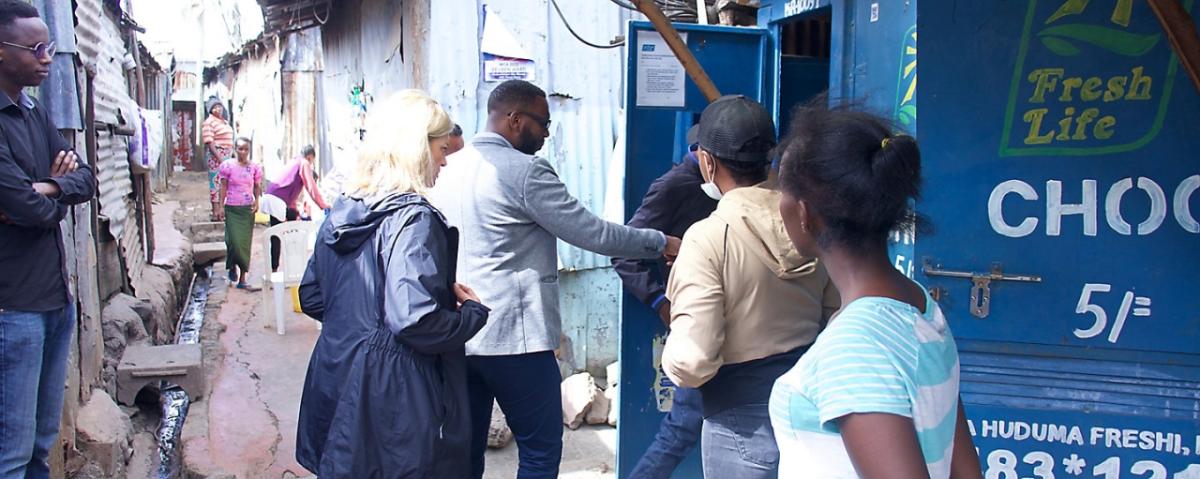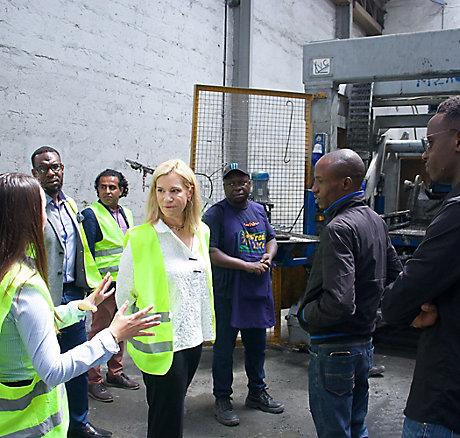World Toilet Day Q&A: Kohler and Sanergy's Mission to Build Healthy, Prosperous Communities
Making hygienic sanitation accessible and affordable in Africa’s largest urban informal settlements
Around the world, over three billion people lack access to safely managed sanitation. Sanitation needs vary from community to community and tackling this challenge requires innovations and partnerships that take into consideration that there is no one-size-fits-all approach to ensuring safe sanitation for all.
On a recent trip to Nairobi, Kenya, Laura Kohler visited with Kohler Innovation for Good partner Sanergy, a nonprofit that is working to build healthy, prosperous communities by making hygienic sanitation accessible and affordable in Africa’s urban informal settlements. While there, she saw firsthand how the container-based sanitation solution Kohler Innovation for Good and Sanergy codeveloped is helping communities. Designed using a human-centered design process for people living without access to safe sanitation systems, the sanitation solution is a container-based toilet that enables safe waste management, while blending seamlessly into the living space.
Part of what makes the collaboration with Sanergy a success is learning how to modify products with real users in the field. This process has helped the team make a tangible impact on people’s lives by providing access to sanitation for communities that need it most.
Lindsay Stradley, Cofounder at Sanergy and two of Kohler’s own Innovation for Good team members, Julia Katz, Associate Product Manager and Hiro Muraoka, Lead Industrial Designer, shared their experience collaborating on this solution and provided insights into why using human-centered design to address sanitation challenges is so important.
The progress Sanergy and Kohler Innovation for Good are making when it comes to bringing sanitation solutions to these communities is inspiring. Can you share why it is so important for a community to be included in the design process and why this was important in your collaboration on container-based sanitation?
Lindsay (Sanergy): Engaging the community in the design process of products and services helps designers fully understand the needs and priorities of the community, which then shapes innovation to build products that meet their needs. It also establishes an open and collaborative dialogue with the community.
Hiro and Julia (Kohler): For us, the human-centered design process begins with empathy for the user. As Lindsay mentioned, this means first understanding their needs, then ideation, and then implementation. Sanergy provides us with a window into the users and their experiences.
Q: What is a human-centered approach to innovation and why is taking this approach so important for these kinds of solutions?
Hiro and Julia: Human-centered design means taking customers into account every step of the process. We meet with the customers, gather their feedback, and put ourselves in the user’s perspective. We send design iterations to the field to collect and analyze data and this feedback dictates the overall structure and shape of the product.
Lindsay: The sanitation challenge is complex to solve, particularly when tackling it using a systemic approach. Using a human-centered design approach provides a framework for stakeholder collaboration, participation, and feedback that stimulates innovation—and leads to the development of desirable and sustainable solutions. This approach has enabled us to expand our portfolio of products and services delivered in cities to solve the sanitation challenge at scale.
Q: How does the collaboration and partnership with Sanergy enable container-based sanitation solutions to impact at scale?
Hiro and Julia: Our partnership with Sanergy allows for Kohler and Sanergy to leverage one another’s strengths to drive growth in the container-based sanitation space. Sanergy brings in-depth market insights and experience, while Kohler brings expertise in design, engineering, and manufacturing. Together, we are able to create a product that truly meets the needs of our customers, while also providing the exceptional quality level that is synonymous with the Kohler brand name.
Q: What does an iterative process look like in terms of field-testing and consumer feedback, and what makes this process so crucial? Can you give an example of this process in action?
Hiro and Julia: We are trying to develop a completely new product unlike anything in the market currently, so there are a lot of unknowns. Field-testing in the community helps us to work collaboratively with the customer to ensure we have the features they need and want. In a 2021 field trial with Sanergy, we analyzed the results and made major changes to our design to ensure we were meeting the needs of the market and customers. Since then, we have done two additional rounds of feedback and design updates.
Lindsay: Our dry, container-based Fresh Life toilet, launched in 2011, has become a favorite and most-preferred solution for urban residents. The popularity is due to the continuous improvements we have made as a result of community feedback. Customers initially asked for the toilet to be made from bricks, and have a floor of white tile, so we sought to understand the reasons for these requests. We learned that our customers wanted the facility to be a durable, clean, and secure structure, so we created a design to meet their needs.
Q: Julia and Hiro, how are you working to embed a human-centered design process here at Kohler and within Innovation for Good?
Julia and Hiro: We are serious about human-centered design at Kohler because of the nature of our business. All our products and services are directly tied to users and their bodies. Human-centered design is a crucial, uncompromisable aspect of our design process. We meet with the customers, gather their feedback, and put ourselves in the user’s perspective. Even with challenges created by the pandemic, we found ways to listen to feedback virtually and continue working closely with the partner and their user.
Q: Lindsay, what is the biggest challenge in sanitation that collaborative innovation can help address?
Lindsay: With cities urbanizing rapidly, far outpacing the growth of infrastructure, the global urban sanitation challenge is still huge. It is critical to develop solutions that can be implemented quickly and modularly and are designed to evolve as cities grow. Collaborative innovation in designing these solutions is critical as it not only brings together expertise, but it helps address a critical financial constraint challenge that deter most solutions from scaling at the pace that cities are growing.
Through initiatives like Safe Water for All and Innovation for Good, Kohler is committed to innovating sustainable solutions and products that seek to address UN Sustainable Development Goal 6, Clean Water and Sanitation for All. Learn more about Kohler’s work with Sanergy on container-based sanitation solutions.




